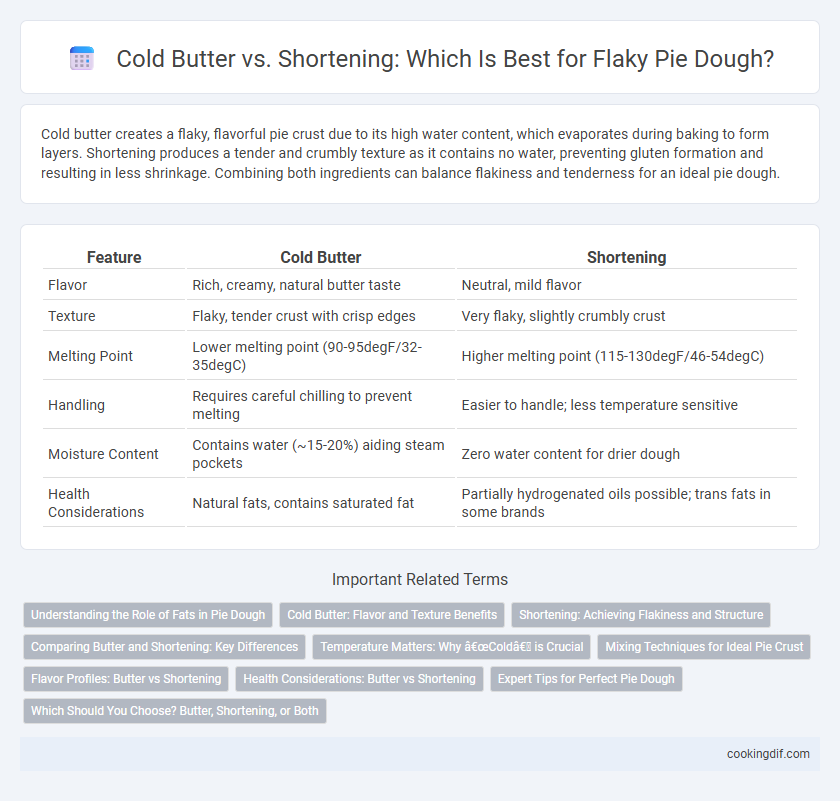Cold butter creates a flaky, flavorful pie crust due to its high water content, which evaporates during baking to form layers. Shortening produces a tender and crumbly texture as it contains no water, preventing gluten formation and resulting in less shrinkage. Combining both ingredients can balance flakiness and tenderness for an ideal pie dough.
Table of Comparison
| Feature | Cold Butter | Shortening |
|---|---|---|
| Flavor | Rich, creamy, natural butter taste | Neutral, mild flavor |
| Texture | Flaky, tender crust with crisp edges | Very flaky, slightly crumbly crust |
| Melting Point | Lower melting point (90-95degF/32-35degC) | Higher melting point (115-130degF/46-54degC) |
| Handling | Requires careful chilling to prevent melting | Easier to handle; less temperature sensitive |
| Moisture Content | Contains water (~15-20%) aiding steam pockets | Zero water content for drier dough |
| Health Considerations | Natural fats, contains saturated fat | Partially hydrogenated oils possible; trans fats in some brands |
Understanding the Role of Fats in Pie Dough
Cold butter creates a flaky texture in pie dough due to its water content that produces steam during baking, while shortening provides tenderness by inhibiting gluten formation. Butter contributes rich flavor and browning, but shortening offers consistent results with less shrinkage. Selecting the right fat balance influences the pie crust's structure, texture, and taste, making the choice essential for desired baking outcomes.
Cold Butter: Flavor and Texture Benefits
Cold butter enhances pie dough by creating a flaky, tender texture due to its solid fat content that forms steam pockets during baking. Its rich, creamy flavor contributes to a more complex and satisfying taste profile compared to neutral shortening. Proper chilling of butter ensures optimal layering, resulting in a crispy crust with a delicate crumb.
Shortening: Achieving Flakiness and Structure
Shortening contributes to flakiness and structure in pie dough by creating a tender, crumbly texture that holds its shape during baking. Its higher melting point compared to butter ensures less spreading, resulting in distinct, flaky layers. This stability makes shortening a preferred choice for achieving a crisp, reliable pie crust.
Comparing Butter and Shortening: Key Differences
Butter provides rich flavor and flaky texture to pie dough, while shortening offers a tender, crumbly consistency with less flavor impact. Butter's water content creates steam during baking, resulting in a lighter crust, whereas shortening's 100% fat content produces a more uniform, stable dough. In terms of handling, butter requires colder temperatures to prevent melting, while shortening remains solid longer, making it easier for shaping and layering.
Temperature Matters: Why “Cold” is Crucial
Cold butter and shortening are essential for achieving a flaky pie crust because their firm texture prevents premature melting, which creates steam pockets during baking; this results in a tender, layered structure. Butter's water content evaporates into steam, promoting flakiness, while shortening's higher melting point provides a sturdier crust without spreading. Maintaining cold ingredients and chilled dough ensures the fat remains solid until baking, preserving the optimal texture and preventing greasy, tough pie crusts.
Mixing Techniques for Ideal Pie Crust
Cold butter creates flaky layers in pie dough by melting during baking, while shortening produces a tender, less flaky crust due to its 100% fat content. Mixing cold butter using the "cutting in" method helps distribute fat evenly, preventing overworking the dough and ensuring a crisp, airy texture. Using shortening requires gentle mixing to avoid excessive gluten development, resulting in a soft, crumbly crust ideal for pies needing delicate structure.
Flavor Profiles: Butter vs Shortening
Cold butter in pie dough contributes a rich, creamy flavor with natural dairy notes that enhance the overall taste, creating a more savory and authentic pie crust. Shortening offers a neutral, almost flavorless profile that allows other pie ingredients to shine without interference. The choice between butter and shortening impacts the pie's flavor intensity and depth, with butter delivering superior taste and shortening providing a subtler base.
Health Considerations: Butter vs Shortening
Cold butter contains natural fats and trace nutrients like vitamins A and E, offering a more natural alternative to shortening, which is a hydrogenated fat often linked to higher trans fat content and increased heart disease risk. Butter's saturated fats may raise cholesterol but also provide beneficial fatty acids, whereas shortening typically contains no cholesterol but may include unhealthy trans fats harmful to cardiovascular health. Choosing cold butter for pie dough supports a cleaner ingredient profile with fewer artificial additives, enhancing overall nutritional quality.
Expert Tips for Perfect Pie Dough
Using cold butter in pie dough enhances flavor and creates a flaky, tender crust due to its water content releasing steam during baking. Shortening, with its higher melting point, offers superior dough stability and a consistently crisp texture, ideal for all-season baking. Combining cold butter and shortening can balance flavor and texture, ensuring the perfect pie crust every time.
Which Should You Choose? Butter, Shortening, or Both
Choosing between cold butter, shortening, or a combination for pie dough depends on desired texture and flavor; cold butter provides rich taste and flaky layers due to its water content, while shortening offers superior tenderness and higher melting point for a more stable crust. Using both can balance flavor and texture, leveraging butter's flavor and shortening's ability to create a tender, non-shrinking dough. Professional bakers often recommend a 50/50 blend to achieve optimal flakiness and crumb structure in pies.
Cold butter vs shortening for pie dough Infographic

 cookingdif.com
cookingdif.com